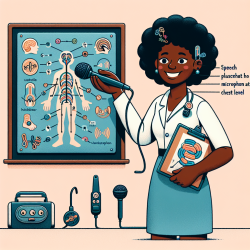In the field of speech-language pathology, staying updated with the latest research and integrating it into clinical practice can be challenging. The research article "Decreasing the Knowledge-to-Action Gap Through Research - Clinical Partnerships in Speech-Language Pathology" highlights a successful approach to bridging this gap through collaborative efforts. This blog will delve into the outcomes of this research and provide actionable insights for practitioners to enhance their skills.
Understanding the Knowledge-to-Action Gap
The knowledge-to-action (KTA) gap refers to the discrepancy between what is known from research and what is practiced in clinical settings. This gap can hinder the adoption of innovative techniques that could significantly benefit patients. In the context of speech-language pathology, the study focused on the use of surface electromyography (sEMG) biofeedback in swallowing rehabilitation for dysphagia patients.
The Study: A Collaborative Approach
The research involved a partnership between the Swallowing Rehabilitation Research Laboratory (SRRL) team and four clinical speech-language pathologists (S-LPs). Despite previous training in sEMG biofeedback, the clinicians had not implemented this technique in their practice. The study provided hands-on mentorship to facilitate the use of sEMG biofeedback, following the KTA process model by Graham et al. (2006).
Key Findings and Implementation Strategies
The post-training interviews revealed several critical insights that can help practitioners overcome barriers and improve their clinical skills:
- Hands-On Mentorship: Clinicians valued the direct support from the SRRL team, which helped them overcome barriers such as time constraints, lack of confidence, and difficulty in staying updated with current research.
- Customized Training: Tailored training sessions and ongoing support were crucial in building clinicians' confidence and competence in using sEMG biofeedback.
- Patient Selection: Assistance in identifying appropriate patients for sEMG biofeedback was vital. The research team helped clinicians understand which patients would benefit most from this technique.
- Evaluation and Feedback: Regular evaluation and feedback from the research team helped clinicians refine their skills and gain new insights into patient performance and therapy outcomes.
Encouraging Further Research
For practitioners looking to improve their skills, engaging in further research and forming partnerships with research teams can be highly beneficial. Consider the following steps:
- Stay Informed: Regularly review current literature and attend workshops to stay updated with the latest advancements in your field.
- Seek Mentorship: Establish connections with research teams or experienced clinicians who can provide guidance and support.
- Participate in Studies: Get involved in research studies to gain hands-on experience with new techniques and contribute to the advancement of your field.
- Implement Action Plans: Develop and follow action plans based on the KTA process model to effectively integrate new knowledge into your practice.
Conclusion
The partnership between the SRRL team and clinical S-LPs demonstrates the value of collaborative efforts in bridging the knowledge-to-action gap. By engaging in further research and seeking mentorship, practitioners can enhance their skills and provide better outcomes for their patients.
To read the original research paper, please follow this link: Decreasing the Knowledge-to-Action Gap Through Research - Clinical Partnerships in Speech-Language Pathology.










